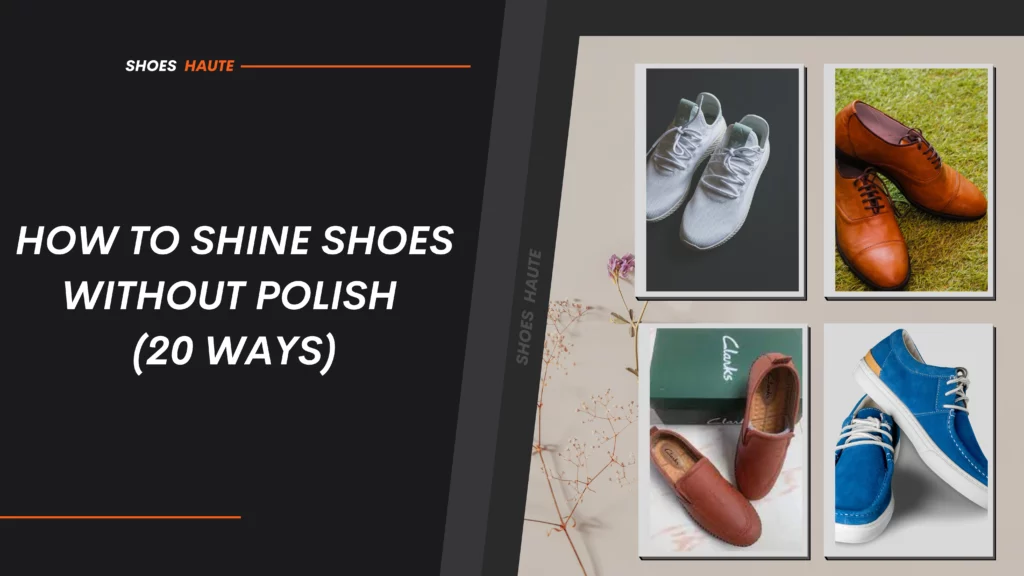
Shoes play a crucial role in our outfits as they have the ability to make or break a look. We put in effort to maintain their cleanliness and shine, but achieving a flawless polish can be challenging, especially without the right products.
However, there’s no need to fret as there are several alternative methods to achieve a perfect shine without the use of polish. Whether you’re on a tight budget, trying to simplify your routine, or lacking polish, this guide will teach you how to achieve a glossy finish for all types of shoes, including leather, suede, and synthetic.
This article will cover the top methods for shining shoes without the use of polish. From different techniques to materials, we will explore the best ways to achieve a perfect shine, eliminating any concerns about how to shine shoes without polish.
Make sure to thoroughly clean your shoes.
- Prior to shining your shoes, it is crucial to thoroughly clean them. This will eliminate any dirt, dust, or grime that may have accumulated and restore their appearance. Properly washing your shoes will not only remove buildup but also ensure they are ready for the shining process.
- To clean your shoes, you’ll need a soft-bristled brush, a clean cloth, and some water. Begin by using the brush to remove any loose dirt or debris from the surface, paying special attention to the soles and edges.
- Next, dampen the clean cloth with water and use it to wipe down the entire shoe, focusing on the dirtiest areas. Be careful not to overly saturate the shoe, and wring out the cloth as needed.
For stubborn stains or marks, you can use a mild soap or detergent on the affected area. Simply apply a small amount onto a damp cloth and gently rub the stained area in a circular motion. Then, use a clean, damp cloth to remove any leftover soap residue.
Once your shoes are clean and dry, it’s time to shine them. Properly cleaning your shoes beforehand ensures that the shine is even and long-lasting.
Method 1: Use Olive Oil

Olive oil, a versatile ingredient known for its use in cooking and healthcare for thousands of years, can also serve as a great alternative to traditional shoe polish. Its natural conditioning properties can nourish and restore shine to your shoes.
- After cleaning your shoes as previously instructed, you can use olive oil to shine them. Simply apply a small amount of olive oil onto a clean, soft cloth and gently rub it onto the shoes in a circular motion. Make sure to cover the entire shoe evenly.
- To achieve an even shinier look, apply a few drops of lemon juice to the cloth and gently rub it in a circular motion on the shoe. This will effectively remove any remaining dirt or grime.
- Allow the olive oil and lemon juice to soak into the leather of your shoes for a few minutes before proceeding. Then, use a clean cloth to gently buff away any excess oil and give your shoes a final shine.
- Using olive oil as a cost-effective replacement for traditional shoe polish can effectively restore the natural shine of your shoes, giving them a like-new appearance. For an added boost in cleaning power, consider incorporating a few drops of lemon juice into the process for an even shinier finish.
Method 2: Use Banana Peel

Did you know that banana peels can be a fantastic alternative to shoe polish? The natural oils and potassium found in the peel can effectively nourish and shine leather shoes. All you need is a ripe banana and a clean cloth to achieve a polished look using this method.
- First, remove the peel from the banana and either eat or dispose of the fruit. Then, use the inside of the peel to rub over your shoes, making sure to cover the entire surface in a circular motion. Be sure to focus on any scuffs or scratches on your sneakers.
- After completing the circular motion with the banana peel, I recommend using a clean towel to polish the surface. Apply light pressure and buff in a circular motion. The natural oils in the banana peel will nourish and shine the leather.
- Using a banana peel to shine your shoes is an affordable and environmentally-friendly method to revitalize their appearance.
Method 3: Linseed Oil And Vinegar


Instead of traditional shoe polish, consider using linseed oil and vinegar for a natural and effective way to achieve a glossy shine on your shoes. Linseed oil, also known as flaxseed oil, is derived from the seeds of the flax plant and is known for its ability to deeply nourish and condition leather, making it a great option for shining shoes.
- To create a linseed oil and vinegar shoe polish, mix equal parts of linseed oil and white vinegar in a small dish. Using a soft cloth, apply the mixture in circular motions, making sure to cover all areas of the shoe, including the seams and edges.
- After applying the linseed oil and vinegar mixture, leave it on the shoes for a few minutes to allow the leather to absorb the oil. Then, use a clean cloth to buff the shoes to a shine. The linseed oil will penetrate the leather, while the vinegar will remove any buildup and create a beautiful glossy finish.
- For individuals who prefer natural and environmentally-friendly options, linseed oil and vinegar shoe polish are excellent alternatives to traditional shoe polish. These ingredients can also be easily found in most grocery stores, making it a budget-friendly option.
Method 4: Use Petroleum Jelly

A great way to make your shoes shine is by using petroleum jelly, a commonly found household item. If you don’t have any regular shoe polish available, it can be a great substitute.
- To use petroleum jelly as a shoe polish, all you need is a clean, dry cloth and a small amount of the jelly. Simply apply a small amount onto the cloth and gently rub it in a circular motion over the entire surface of your shoes, including the soles and edges.
- Once you have applied the jelly, use a clean cloth to buff your shoes to a shine. This will help the petroleum jelly penetrate the leather and create a protective barrier, preventing any scuffs or scratches.
- Although petroleum jelly is a popular alternative to traditional shoe polish, it may not work as well on suede or synthetic materials based on my experience. Additionally, it is important to note that petroleum jelly can darken the color of your shoes, so it is recommended to test it on a small and insignificant area first.
Method 5: Use Walnut Oil

Walnut oil has been used as a wood polish and conditioner for many years and has recently gained popularity as a substitute for traditional shoe polish. Made from the nuts of walnut trees, this natural oil contains elements that are beneficial for repairing and protecting leather shoes.
- When used as a shoe polish, walnut oil can help bring back the natural shine and color of leather shoes while also providing protection from weather elements. It is particularly effective on brown leather shoes, enhancing the warm tones of the leather.
- To use walnut oil as a shoe polish, you will need a soft cloth and a small amount of the oil. Apply the oil onto the cloth and gently rub it in a circular motion over the entire surface of your shoes, making sure to cover every part.
- After applying the walnut oil, let your shoes sit for a few minutes to allow the oil to absorb into the leather. Then, use a clean cloth to buff them to a shine.
- Walnut oil is a non-toxic and natural substitute for traditional shoe polish that can be used on various types of leather shoes. For those who prefer natural products and want to avoid chemicals found in regular shoe polishes, walnut oil is a great option.
Method 6: Use Beeswax
Beeswax is a widely used natural alternative to shoe polish. It is a natural wax produced by honeybees and is known for its exceptional waterproofing and conditioning properties, making it a great ingredient for shining shoes.
- To use beeswax for shining shoes, all you need is a clean cloth and a small amount of the wax. Simply apply the wax onto the surface of your shoes using the cloth, making sure to spread it evenly in a circular motion and covering the entire shoe.
- Once you have applied the beeswax, gently rub the shoes with a clean cloth to evenly distribute the wax and create a glossy finish. Be sure to carefully buff the shoes, focusing on any areas where the wax may have built up.
- Beeswax is an excellent natural substitute for traditional shoe polish as it can provide a brilliant shine while also nourishing and protecting the leather. However, it is important to note that beeswax may not be suitable for all types of shoes, so it is recommended to test it on a small area before using it on the entire shoe.
Method 7: Use Vegetable Oil
Vegetable oil, a common kitchen ingredient, can also be used to polish your shoes.In case you run out of shoe polish, vegetable oil is a great alternative. Not only is it natural and inexpensive, but it also provides your shoes with a great shine without the use of harmful chemicals.
- To use vegetable oil as a shoe shine, you will need a soft cloth and a small amount of oil. Just apply a small amount onto the cloth and gently rub it in a circular motion over the surface of your shoes.
- For an even shine, make sure to cover the entire shoe, including the edges and soles, when using vegetable oil. It is a safe option for various shoe materials, such as leather and synthetics.
Method 8: Use Hair Gel
Hair gel is not just for styling hair, it can also work as an alternative for shoe polish. If you find yourself without any polish, try using hair gel to give your shoes a quick shine.

- To use hair gel as a shoe polish, you will need a clean cloth and a small amount of hair gel. Start by applying the hair gel to the cloth and gently rubbing it in circular motions onto your shoes. Be sure to cover all parts of the shoe, including the edges and soles.
- Once you have applied the hair gel, use a clean cloth to buff your shoes in circular motions. This will help to distribute the gel evenly and create a shiny finish.
Please keep in mind that using hair gel instead of shoe polish is not a permanent fix. The shine from the hair gel may not last as long as traditional polish, and it may not be suitable for all shoe materials. However, in an emergency, hair gel can be a useful substitute for a temporary shine on your shoes.
Method 9: Use Coconut Oil
Coconut oil is a multipurpose substance that can be used for various purposes, such as a substitute for shoe polish. Utilizing coconut oil as a shoe polish can be a natural and effective method to achieve a glossy shine on your shoes.
- Before using coconut oil as a shoe polish, it is essential to clean your shoes thoroughly. After they are dry, use a soft cloth or brush to gently apply a small amount of coconut oil to the shoes. Be sure to work the oil into the surface of the shoes, covering all areas.
- Allow the coconut oil to penetrate and nourish the leather on your shoes for a few minutes. Then, use a clean cloth to gently rub the surface of the shoes, removing any excess oil and leaving behind a glossy finish.
- Coconut oil is an excellent alternative to traditional shoe polish, as it provides a natural way to shine and protect your shoes. Additionally, it can help to maintain and nourish the leather, prolonging the lifespan of your shoes.
Method 10: Use Rubbing Alcohol
Isopropyl alcohol, also known as rubbing alcohol, is a versatile household item that can be used for various purposes, including shining shoes. It can be an effective alternative to shoe polish, especially in situations where it is not readily available.
To start,you will need a soft cloth or rag and a small amount of the alcohol. Using the cloth, gently rub the alcohol onto the surface of your shoes. The alcohol will effectively remove dirt and stains, leaving your shoes clean and shiny.
If your shoes have scuff marks, rubbing alcohol can also help remove them. Simply apply a small amount of the alcohol onto a clean cloth or rag and gently rub the affected area to eliminate the marks.
An advantage of using rubbing alcohol for shoe shining is its quick drying time and lack of residue. This guarantees that your shoes will be left clean and shiny, with no sticky or greasy film.
Method 11: Use Paraffin Wax
When it comes to leather shoes, paraffin wax can be an excellent alternative to traditional shoe polish. This natural wax is derived from petroleum and is readily available. It is a great solution for individuals looking to shine their shoes without having to use traditional shoe polish.
- To shine your shoes with paraffin wax, you will need a soft-bristled brush, a clean towel, and some paraffin wax.
- As mentioned earlier in this article, be sure to thoroughly clean your shoes before proceeding.
- Then, take a small amount of paraffin wax and gently spread it in circular motions over the surface of your shoes. Be sure to apply the wax evenly, focusing on any scuffed or scratched areas.
- Once the wax has been applied, gently buff your shoes with a soft-bristled brush. This will help to evenly distribute the wax and create a polished finish.
- Utilizing paraffin wax as a shoe polish is a cost-effective and efficient method to achieve a shiny finish on your shoes. Not only will it enhance the appearance of your shoes, but it will also provide protection against environmental factors.
Method 12: Use Potato Peel

It may come as a surprise, but potato peels can be surprisingly effective for shoe polishing. Due to their natural oils, they are a great option for restoring and protecting leather shoes, making them a great alternative to traditional shoe polish.
- To Begin,Gently rub the inside of a potato peel in circular motions over the surface of your shoes. Be sure to cover all areas, including the edges and seams. Once complete, use a clean cloth to buff the shoes until they shine.
- While potato peels can be effective for shining leather shoes, they can also be used on suede or synthetic leather shoes. However, it is recommended to first test the method on a small, inconspicuous area of the shoe before applying it to the entire surface.
- Not only is using potato peels as a shoe shine alternative effective, but it is also environmentally friendly and cost-efficient. So, the next time you find yourself without shoe polish, consider using potato peels instead.
Method 13: Use Orange Peel

Another great option for shining shoes without polish is using orange peels. The natural oils found in oranges can be used to shine and protect shoes, while their acidic properties can help remove stubborn stains or marks.
- To use orange peel as shoe polish, start by peeling an orange and removing as much of the white pith as possible. Tear the peel into small pieces and gently rub the inside of the peel in circular motions over your shoes. Be sure to cover all areas, including the soles and edges of the shoes.
- Once the orange peel has been applied, use a soft cloth to gently polish your shoes. The natural oils from the peel will help to nourish and protect the shoes, leaving them with a shiny finish.
- Utilizing orange peel as a shoe polish is not only environmentally friendly, but it is also a cost-effective alternative to traditional shoe polish. Additionally, it leaves your shoes with a refreshing, citrus scent.
- The next time you are in need of shoe shining, consider using orange peel as an alternative. You may be pleasantly surprised by the impressive results it can produce. The natural oils in the peel are ideal for adding shine and luster to your shoes.
- In my personal experience, it is a fantastic substitute for traditional shoe polish and can significantly enhance the appearance of your footwear.
Method 14: Use Lip Balm
- Lip balm may not be the first thing that comes to mind when thinking of shoe polish, but it can be surprisingly effective. Its waxy texture makes it an ideal substitute, as it creates a protective layer on the surface of the shoe, providing a shiny finish and protecting it from moisture and dust.
- To shine your shoes using lip balm, opt for a colorless or clear balm and gently apply it to the surface of the shoe using a soft cloth.
- Once applied, make sure to evenly coat the entire surface of the shoe with the lip balm. Its waxy texture will help to fill in any scuffs or scratches and create a protective layer.
- Once the lip balm has been applied, use a clean, dry towel to buff the shoe to a high shine. The result will be a beautifully polished surface that not only looks great, but also provides protection for your shoes.
- Lip balm is a cost-effective and easy alternative to traditional shoe polish, making it an excellent option for individuals looking to shine their shoes without using polish.
Method 15: Use Oregano Leaves
- Oregano leaves can serve as a great alternative to traditional shoe polish. The natural oils found in these leaves help to moisturize leather and provide a beautiful shine. Additionally, oregano leaves have antibacterial and antifungal properties, making them a beneficial choice for maintaining shoes.
- To create shoe polish using oregano leaves, crush a handful of fresh leaves to release their natural oils. Then, gently rub the crushed leaves onto the surface of your shoes in circular motions, being sure to cover all areas including the soles and edges.
- After applying the oregano oil, allow it to saturate the leather for a few minutes before lightly buffing the shoes with a soft-bristled brush. This will help to evenly distribute the oil and create a beautiful shine.
- While oregano leaves may not provide the same level of shine as traditional shoe polish, they are a fantastic natural alternative. Their antibacterial and antifungal properties can also aid in keeping shoes clean and odor-free.
Method 16: Use Hibiscus Flower

Not only are hibiscus flowers aesthetically pleasing, but they also have practical uses. Often used in hair care products and as a natural dye, they can also be utilized to shine shoes without the need for polish.
- To shine your shoes using hibiscus flowers, begin by crushing fresh flowers into a paste. Alternatively, you can purchase dried hibiscus flowers at health food stores or online.
- Once you have crushed the flowers, mix them with a small amount of water until a thick, sticky consistency is achieved. Then, use a soft-bristled brush or cloth to apply the paste to your shoes, making sure to cover the entire surface.
- After applying the paste, allow it to dry completely before using a clean, dry cloth to buff the shoes to a high shine. The natural oils and waxes in hibiscus flowers will help to nourish and protect the shoes, leaving them looking glossy and new.
Hibiscus flowers are a great eco-friendly alternative to traditional shoe polish. They do not contain any harsh chemicals or synthetic substances, making them a safe and natural option for shining shoes.
Method 17: Use Mild Shampoo
- In the event that you do not have any shoe polish available, a mild shampoo can be used to achieve a brilliant shine for your shoes.
- Mild shampoos are gentle on the material of shoes and can be effectively used on a variety of materials, such as leather and synthetic fabrics.
- To shine shoes with shampoo, mix a small amount of the shampoo with water to create a soapy solution. Then, dip a soft cloth into the solution and wring out any excess water. Use the cloth to gently apply the solution onto the shoes in circular motions, ensuring even distribution.
- After applying the solution, allow your shoes to dry completely. Once dry, use a soft-bristled brush to buff the shoes and bring out the shine. If desired, you can repeat the process for a more noticeable shine. This is a cost-effective and easy method that can produce impressive results.
Method 18: Use Body Lotion
- Believe it or not, body lotion can be a surprisingly effective alternative to traditional shoe polish. While it is typically used to moisturize and soften skin, it can also provide a subtle shine for your shoes.
- In my personal experience, utilizing body lotion as a shoe polish is a fantastic alternative that can result in smooth and lustrous footwear.
- To use body lotion as a substitute for shoe polish, you will need a soft cloth and a small amount of lotion. Apply the lotion onto the cloth and use circular motions to gently rub it onto the surface of your shoes. Be sure to apply it evenly and focus on areas that require more shine.
- Once the lotion has been applied, use a clean towel to polish the shoes and achieve a natural shine. This method is particularly useful for suede shoes, as it can help restore their natural texture and color.
- Although body lotion may not provide the same level of shine as traditional shoe polish, it can serve as a good alternative when in a bind. Additionally, it is a great way to moisturize and protect your shoes, ultimately prolonging their lifespan.
Method 19: Use A Non-Toxic Permanent Marker
- When using a non-toxic permanent marker to shine shoes, begin by selecting a marker that closely matches the color of your shoes. Then, use the marker to color in any scuffs or scratches, ensuring the ink is applied evenly and smoothly.
- After applying the ink, use a soft-bristled brush to gently buff it into the leather or synthetic material of your shoes. When brushing, be sure to use a circular motion and avoid applying too much pressure to prevent any damage to the shoes.
- Although this method may not provide the same long-lasting shine as traditional shoe polish, it is a convenient and effortless way to cover up small scuffs and scratches on your shoes.
- In addition to its convenience, using a non-toxic permanent marker as a shoe polish alternative is a more environmentally-friendly option compared to traditional shoe polish.
Method 20: Use Nail File

A nail file can be used as a substitute for shoe polish. This tool is typically used to shape and smooth the edges of nails, but it can also effectively remove scuff marks and scratches from shoes.
- To use a nail file for shining shoes, begin by moistening the scuffed or scratched area with water. Next, gently rub the damaged spot with light pressure, utilizing the rough surface of the nail file to smooth out any scratch or scuff marks.
- When using a nail file on your shoes, be sure to use a gentle touch to avoid causing excessive damage. Once the scuff mark or scratch has been removed, make sure to thoroughly clean the shoe before proceeding with the shining process.
- While using a nail file to shine shoes without polish can be a useful trick, it’s important to keep in mind that it may not be suitable for all types and materials of shoes.
- To prevent any potential damage, it’s always a good idea to test the nail file on a small, inconspicuous area before using it on the entire shoe.
- Based on my observations, taking this simple precaution can help prevent any damage to your shoes and maintain their appearance.
Conclusion
Now that you have discovered the techniques and obtained the answer for shining shoes without polish, you can see the benefits of this environmentally friendly and cost-effective method. Not only does it save you time and money, but it is also a valuable skill to have.
By utilizing the right tools and following the proper steps, I am confident that you can achieve a shine on your shoes that is comparable to that of traditional shoe polish.
Shining shoes without polish is a straightforward and efficient method for maintaining the quality of your footwear. With some practice and the right tools, you can achieve a perfect shine every time.
Frequently Asked Questions
-
Is it possible to shine my shoes without using polish?
Absolutely, you can shine your shoes without polish by using common household items like a mixture of water and vinegar, baking soda, or even a banana peel.
-
Is it true that shining shoes without shoe polish take longer than using shoe polish?
While it may require more manual effort and a few additional steps, shining shoes without polish can still produce excellent results comparable to using shoe polish.
-
Can I use a nail file on any kind of shoe?
No,It is not recommended to use a nail file on any type of shoe material. While it can effectively remove scuff marks and scratches from leather or suede shoes, using it on other materials like canvas or mesh may result in damage to the shoe.
-
How frequently should I shine my shoes without using polish?
The recommended frequency for shining shoes without polish depends on how often they are worn and the conditions they are worn in. Typically, it is advised to shine your shoes once a week or as needed.
-
Will shine shoes without polishing damage the leather?
As long as the correct tools and techniques are used, shining shoes without polish will not cause any harm to the leather. In fact, it can help maintain the overall condition of the leather.





